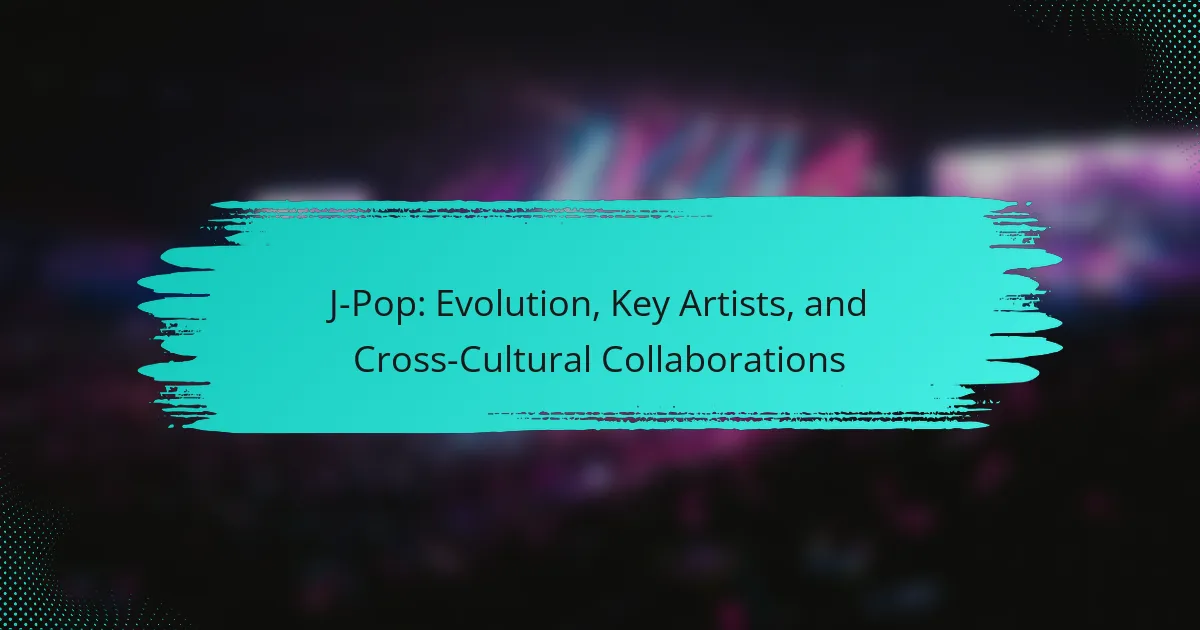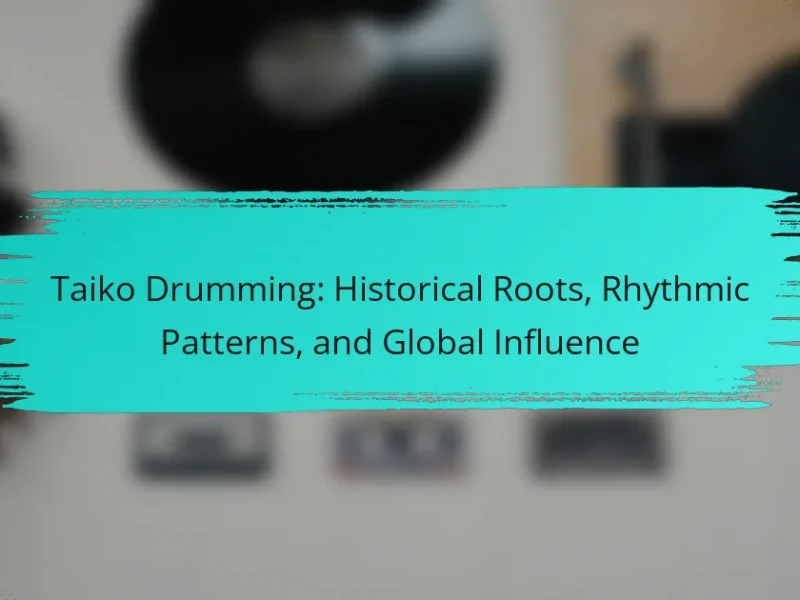J-Pop has transformed over the decades, blending diverse musical styles and cultural influences. This article explores its evolution from city pop to modern digital sounds, highlights key artists like Kenshi Yonezu and Perfume, and examines cross-cultural collaborations that enhance its global appeal. Additionally, it discusses the role of music labels in shaping the industry and the themes prevalent in J-Pop lyrics.

How has J-Pop evolved over the decades?
J-Pop has evolved significantly over the decades, incorporating diverse influences and styles. In the 1980s, J-Pop emerged from city pop, characterized by catchy melodies and urban themes. The 1990s introduced iconic artists like Namie Amuro and Hikaru Utada, who blended pop with R&B and hip-hop elements, broadening its appeal.
The 2000s saw the rise of digital technology, allowing for innovative music production and distribution. Artists such as Arashi and Koda Kumi gained prominence, showcasing a mix of genres and cross-cultural collaborations. In recent years, J-Pop has embraced global influences, with collaborations featuring Western artists and genres like EDM, reflecting a unique fusion of cultures.
Overall, J-Pop’s evolution is marked by its adaptability and willingness to incorporate new sounds, making it a dynamic force in the global music scene.
What are the key milestones in J-Pop history?
Key milestones in J-Pop history include the genre’s emergence in the 1960s, the rise of influential artists in the 1980s, and the global expansion in the 2000s. In the 1960s, artists like Kyu Sakamoto popularized J-Pop with hits like “Sukiyaki.” The 1980s saw the introduction of iconic groups such as Southern All Stars and the influence of city pop. The 1990s marked the debut of leading figures like Namie Amuro and Hikaru Utada, who shaped the genre’s modern sound. By the 2000s, J-Pop experienced cross-cultural collaborations, expanding its reach internationally through artists like Kyary Pamyu Pamyu and collaborations with Western musicians.
Which genres have influenced the development of J-Pop?
J-Pop has been influenced by various genres, including rock, pop, electronic, and hip-hop. These genres have shaped its sound and style, leading to a unique fusion. Rock introduced a strong instrumental presence, while electronic music contributed to innovative production techniques. Hip-hop has added rhythmic complexity and lyrical depth, creating a diverse musical landscape.
How do cultural shifts impact J-Pop trends?
Cultural shifts significantly influence J-Pop trends by introducing diverse musical styles and themes. Globalization has led to cross-cultural collaborations, enriching J-Pop with elements from various genres. For instance, the integration of hip-hop and R&B has transformed traditional J-Pop soundscapes, making them more accessible to international audiences. Additionally, social media platforms have accelerated the dissemination of trends, allowing artists to reach wider demographics and adapt to changing listener preferences rapidly. As a result, J-Pop continues to evolve, reflecting both local and global cultural dynamics.
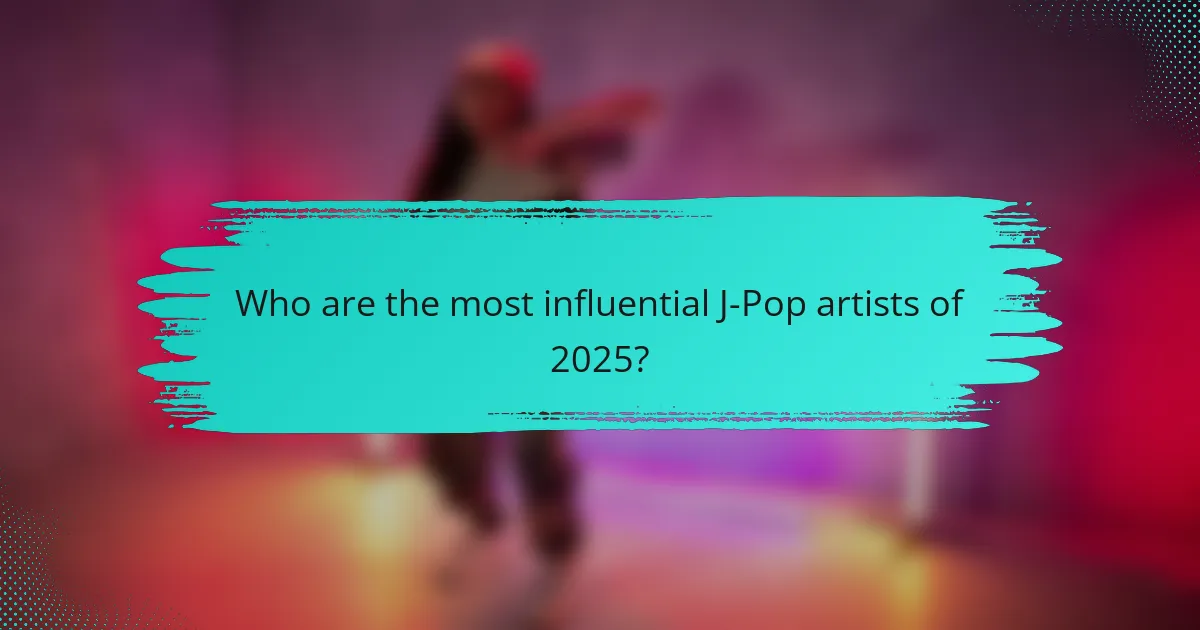
Who are the most influential J-Pop artists of 2025?
The most influential J-Pop artists of 2025 include Kenshi Yonezu, Perfume, and Arashi. These artists have shaped the genre through innovative music styles and cross-cultural collaborations. Kenshi Yonezu combines pop with traditional elements, while Perfume is known for their electronic sound and choreography. Arashi’s impact stems from their extensive fan engagement and media presence. Each artist exemplifies the evolution of J-Pop, contributing to its global appeal.
What makes Hikaru Utada a standout figure in J-Pop?
Hikaru Utada stands out in J-Pop due to her unique fusion of genres and profound lyrical depth. As a pioneer, she blends pop, R&B, and electronic music, creating a distinctive sound that resonates globally. Her debut album, “First Love,” remains the best-selling album in Japan, showcasing her commercial success. Utada’s ability to convey complex emotions through relatable themes sets her apart, making her a key figure in the evolution of J-Pop. Additionally, her cross-cultural collaborations, such as with Western artists, highlight her global appeal and influence in the music industry.
How has Arashi shaped the boy band landscape in Japan?
Arashi has significantly influenced the boy band landscape in Japan by setting new standards for performance and fan engagement. They pioneered the use of multimedia in concerts, integrating elaborate visuals and storytelling. Their diverse music styles, from pop to rock, broadened the appeal of J-Pop. Arashi’s commitment to cross-cultural collaborations introduced international elements into their music, enhancing global interest in Japanese pop culture. Their longevity and consistent chart success established a template for future boy bands, emphasizing the importance of versatility and connection with fans.
Which emerging artists are redefining J-Pop today?
Several emerging artists are redefining J-Pop today, including Aimer, Kenshi Yonezu, and Yorushika. These artists blend traditional J-Pop elements with diverse genres, enhancing global appeal. Aimer’s unique vocal style and emotional storytelling resonate widely, while Kenshi Yonezu’s fusion of pop and rock has garnered international acclaim. Yorushika’s innovative use of narrative in music reflects a fresh approach to songwriting, attracting a younger audience. Their contributions highlight the evolution of J-Pop, showcasing its adaptability and cultural significance.

What role do music labels play in the J-Pop industry?
Music labels are crucial in shaping the J-Pop industry by managing artist development, production, and marketing. They provide financial backing, ensuring high-quality recordings and promotional strategies. Labels also facilitate collaborations between artists, broadening their reach and influence. Notably, major labels like Sony Music Japan and Avex Trax have played pivotal roles in launching successful careers for key J-Pop artists, contributing to the genre’s global appeal.
How do major labels differ from independent labels in J-Pop?
Major labels in J-Pop often have extensive resources and global reach, while independent labels focus on niche markets and artistic freedom. Major labels typically invest heavily in marketing and distribution, securing wider radio play and international collaborations. Independent labels prioritize unique artist development and creative control, allowing for diverse musical experimentation. This difference shapes the overall landscape of J-Pop, influencing both mainstream hits and underground movements.
What impact do label partnerships have on artist success?
Label partnerships significantly enhance artist success by expanding reach and credibility. Collaborations with established labels provide resources, marketing strategies, and access to broader audiences. For instance, artists like Kyary Pamyu Pamyu have gained international recognition through strategic label partnerships, showcasing the power of cross-cultural collaborations. These partnerships often lead to increased streaming numbers and chart performance, illustrating their impact on an artist’s trajectory.
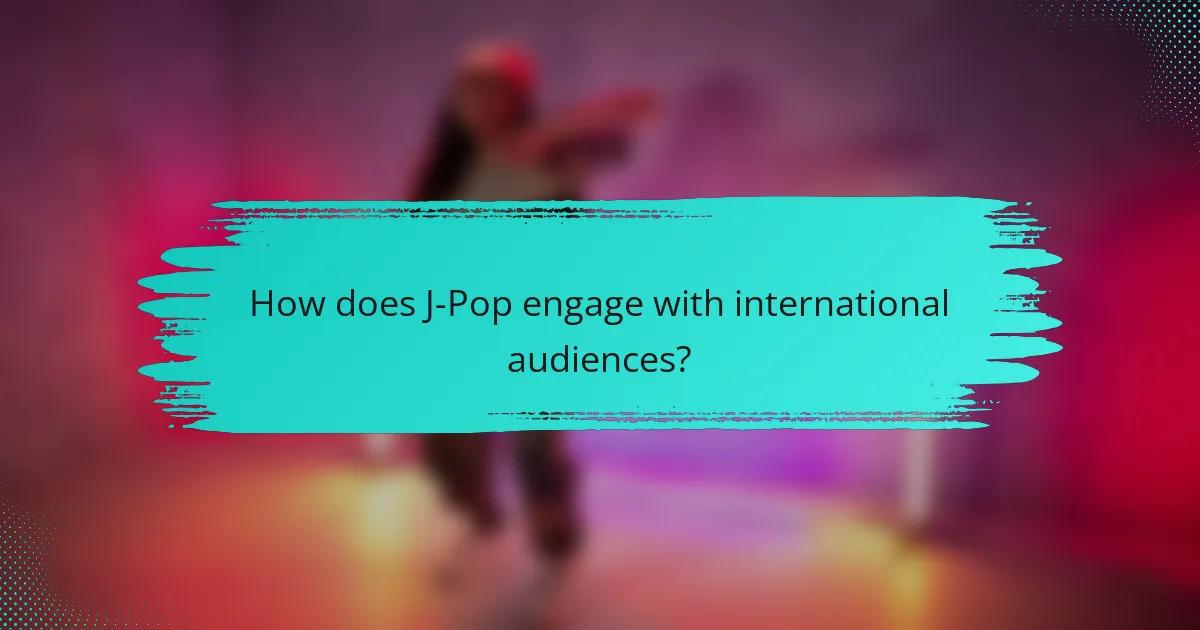
How does J-Pop engage with international audiences?
J-Pop engages with international audiences through innovative collaborations, appealing visuals, and global distribution strategies. Key artists like Kyary Pamyu Pamyu and Arashi have successfully integrated Western influences, attracting diverse fans. Cross-cultural projects, such as collaborations with Western musicians, enhance its global appeal. Additionally, social media platforms facilitate worldwide access, fostering a vibrant international community.
Which cross-cultural collaborations have gained popularity?
Cross-cultural collaborations in J-Pop have gained popularity through partnerships with Western artists and genres. Notable examples include the collaboration between Kyary Pamyu Pamyu and American DJ Diplo, and the fusion of J-Pop with K-Pop elements, as seen in the works of artists like Perfume. These collaborations enhance global reach and introduce diverse musical influences, reflecting the evolving landscape of J-Pop.
What strategies do J-Pop artists use to reach global fans?
J-Pop artists employ various strategies to connect with global fans, including social media engagement, international collaborations, and multilingual content. They leverage platforms like YouTube and Instagram to share music and behind-the-scenes content, fostering a sense of community. Collaborations with Western artists expand their reach and introduce unique sounds, while songs in English or with subtitles make their music more accessible. These approaches enhance their global presence and appeal, tapping into diverse listener bases.
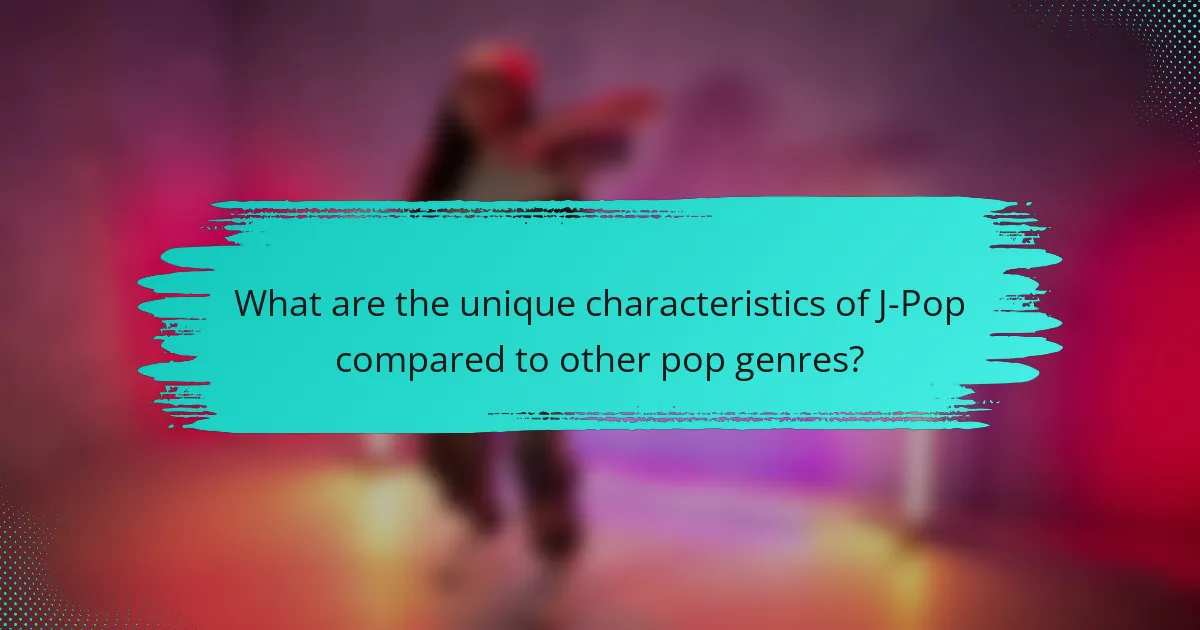
What are the unique characteristics of J-Pop compared to other pop genres?
J-Pop is distinct from other pop genres due to its unique blend of cultural influences, musical styles, and visual aesthetics. Key characteristics include a strong emphasis on catchy melodies, diverse sub-genres, and elaborate performances.
J-Pop often incorporates traditional Japanese instruments alongside modern electronic sounds, creating a fusion that is not commonly found in Western pop. The lyrics frequently explore themes of youth, love, and personal identity, resonating deeply with the Japanese audience.
Notable artists like Hikaru Utada and Arashi have contributed to the genre’s evolution, pushing boundaries through cross-cultural collaborations with international musicians. This has expanded J-Pop’s reach beyond Japan, influencing global pop culture.
The genre’s visual presentation is also unique, with colorful fashion styles and choreographed dance routines that enhance the overall experience. This combination of music, culture, and visual artistry sets J-Pop apart from other pop genres.
How do visual aesthetics influence J-Pop music videos?
Visual aesthetics significantly influence J-Pop music videos by enhancing storytelling and emotional connection. Color palettes, choreography, and fashion choices create a distinct visual identity, attracting diverse audiences. High production values and innovative visuals elevate the overall experience, making J-Pop videos memorable. Additionally, collaborations with artists from different cultures introduce unique styles, further enriching the aesthetic appeal.
What role does fashion play in J-Pop artist branding?
Fashion plays a crucial role in J-Pop artist branding by shaping their public image and identity. Artists often use distinctive styles to express individuality, enhance visual appeal, and connect with fans. This visual representation can include unique clothing, accessories, and hairstyles that resonate with cultural trends.
The integration of fashion into J-Pop is evident in artists like Kyary Pamyu Pamyu, whose eclectic style reflects her music’s playful nature. Additionally, collaborations with fashion designers further elevate an artist’s brand, creating a synergy between music and fashion. As a result, fashion becomes a powerful tool for storytelling and audience engagement in the J-Pop industry.
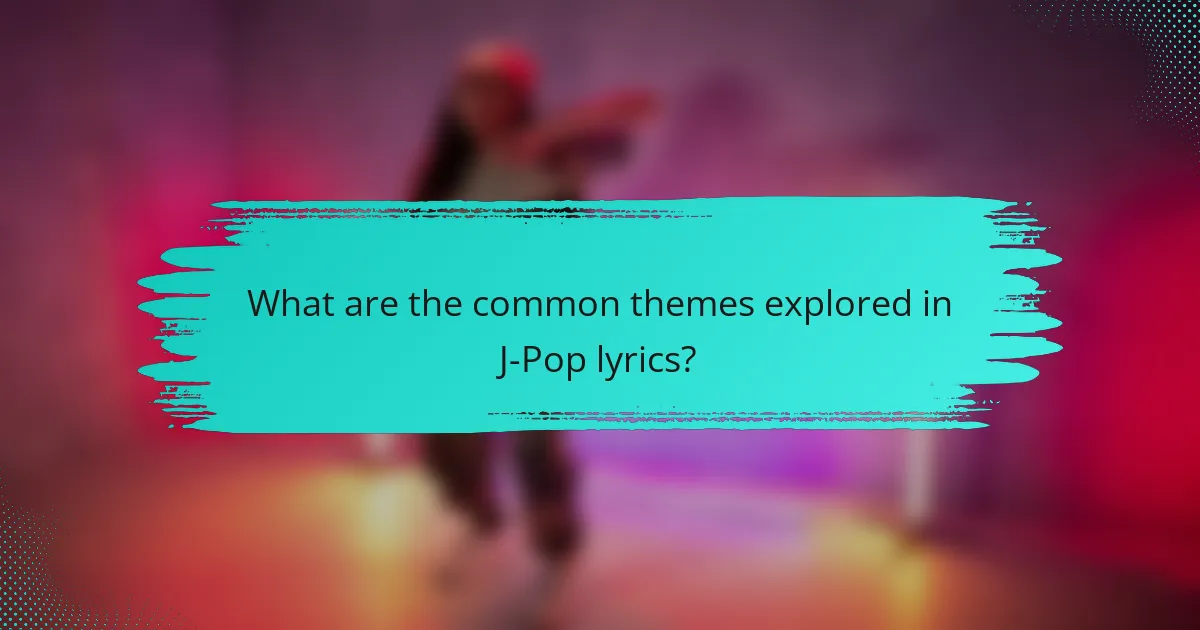
What are the common themes explored in J-Pop lyrics?
J-Pop lyrics commonly explore themes of love, nostalgia, identity, and social issues. Love remains a central theme, often depicted through romantic relationships or unrequited feelings. Nostalgia frequently surfaces, reflecting on past memories and experiences, resonating with listeners’ sentiments. Identity is another important theme, addressing personal struggles and self-discovery, particularly among youth. Social issues, such as mental health and societal pressures, are also prevalent, showcasing the genre’s ability to engage with contemporary challenges. These themes collectively contribute to J-Pop’s emotional depth and cultural relevance.
How do J-Pop songs reflect societal issues in Japan?
J-Pop songs often mirror societal issues in Japan, addressing topics like mental health, youth struggles, and social pressures. Artists like Kenshi Yonezu and Perfume incorporate these themes into their lyrics, reflecting contemporary challenges. For example, Yonezu’s “Lemon” explores grief and loss, resonating with listeners facing similar experiences. Additionally, the genre’s evolution shows a growing awareness of issues such as gender equality and environmental concerns, indicating a shift in cultural narratives. This connection between music and society fosters dialogue and awareness among fans, making J-Pop a powerful medium for social commentary.
What emotional narratives are prevalent in J-Pop?
Emotional narratives in J-Pop often explore themes of love, heartbreak, and personal growth. Artists convey complex emotions through relatable lyrics and melodious compositions. The genre’s storytelling often reflects societal issues, such as youth struggles and cultural identity. Unique attributes include the use of vivid imagery and metaphors that resonate with listeners, fostering a deep emotional connection.
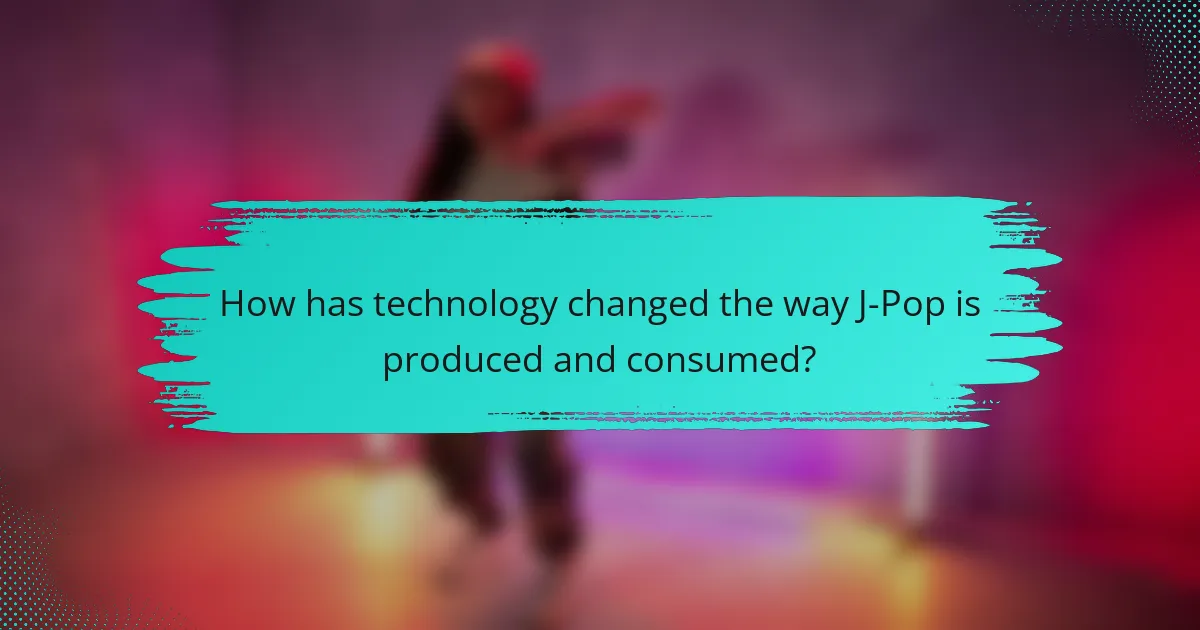
How has technology changed the way J-Pop is produced and consumed?
Technology has significantly transformed J-Pop production and consumption by enhancing accessibility and creativity. Digital platforms allow artists to reach global audiences instantly. Advanced production software enables innovative sound design, while social media fosters direct artist-fan interactions. Streaming services have shifted consumption patterns, making music available on-demand. This evolution has led to diverse collaborations, blending traditional J-Pop with international genres, enriching the overall landscape.
What platforms are most popular for J-Pop streaming?
The most popular platforms for J-Pop streaming include Spotify, Apple Music, YouTube, and Amazon Music. These platforms offer extensive catalogs of J-Pop artists and tracks, catering to a global audience. Spotify leads with its personalized playlists and user engagement features. YouTube provides visual content alongside music, enhancing the listening experience. Apple Music and Amazon Music also contribute significantly to the accessibility and promotion of J-Pop.
How do social media trends impact J-Pop promotion?
Social media trends significantly enhance J-Pop promotion by increasing visibility and engagement. Platforms like TikTok and Instagram allow artists to reach global audiences quickly. Viral challenges and dance trends can propel songs to mainstream success. Collaborations with influencers amplify promotional efforts, creating cross-cultural connections. The rapid sharing of content fosters a dynamic music landscape, allowing J-Pop to evolve and adapt to diverse tastes.
What innovations are shaping the future of J-Pop music production?
Innovations such as AI music composition, virtual reality concerts, and cross-genre collaborations are shaping J-Pop’s future. AI tools enable artists to create unique sounds, while VR enhances live experiences. Collaborations with global artists expand J-Pop’s reach and influence, integrating diverse musical styles and cultures. These advancements reflect the genre’s adaptability and ongoing evolution.
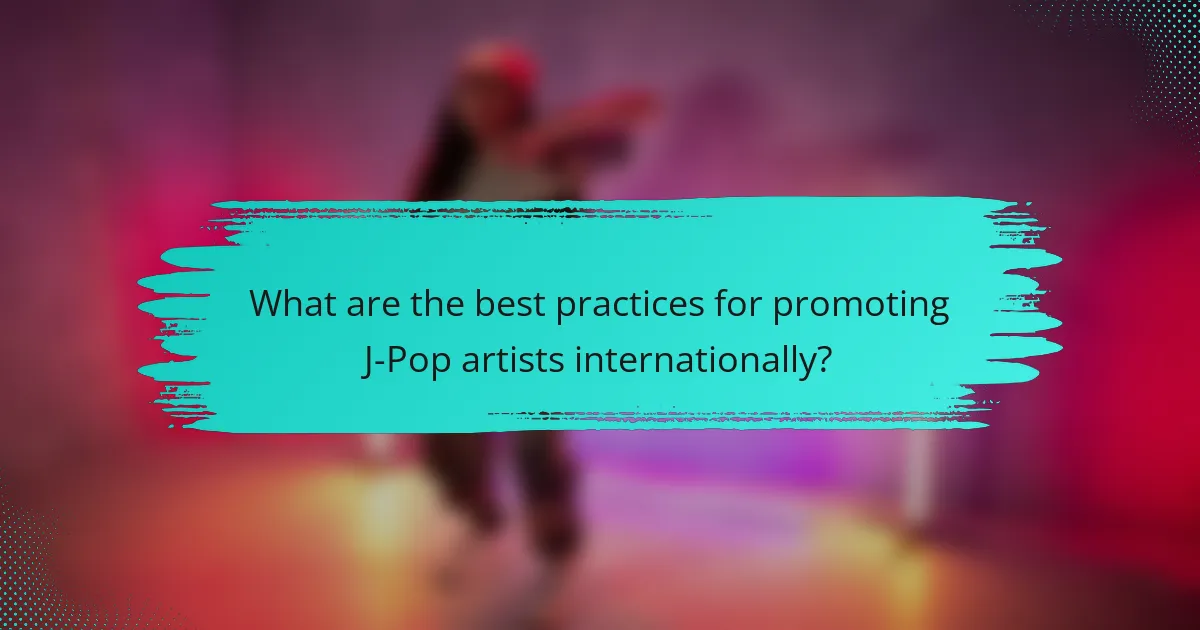
What are the best practices for promoting J-Pop artists internationally?
To promote J-Pop artists internationally, leverage social media platforms, collaborate with global musicians, and participate in international music festivals. Engaging with diverse fanbases boosts visibility and fosters cross-cultural connections.
Developing strategic marketing campaigns that highlight unique attributes of J-Pop, such as its vibrant visuals and innovative sound, can attract global audiences. Utilizing streaming platforms for wider distribution enhances accessibility and reach.
Moreover, creating localized content that resonates with different cultures can strengthen international appeal. Collaborations with artists from various genres can introduce J-Pop to new listeners, expanding its influence worldwide.
Which marketing strategies resonate with global audiences?
Engaging marketing strategies for J-Pop include social media campaigns, influencer collaborations, and targeted content localization. These approaches resonate with global audiences by leveraging cultural relevance and emotional connections.
Social media platforms like Instagram and TikTok effectively showcase J-Pop artists and their music. Influencer collaborations amplify reach and authenticity, while localized content ensures cultural nuances are respected, enhancing audience engagement.
Key artists such as Arashi and Perfume exemplify successful cross-cultural collaborations, integrating diverse musical elements to attract international fans. Their innovative approaches set trends within the global music landscape.
As a result, J-Pop continues to evolve, adapting marketing strategies that resonate across borders, fostering a vibrant community of dedicated listeners worldwide.
What common mistakes should J-Pop artists avoid when entering foreign markets?
J-Pop artists should avoid cultural insensitivity, lack of market research, and over-reliance on local trends when entering foreign markets. Understanding cultural nuances is crucial for acceptance. Researching audience preferences ensures relevance and appeal. Additionally, adapting to international music trends can enhance global reach.
